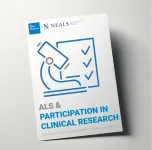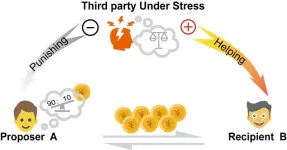(Press-News.org) AUSTIN, Texas -- The Securities and Exchange Commission acts as Wall Street’s traffic cop, fining companies for such infractions as securities fraud and insider trading. New research from Texas McCombs finds another parallel between the SEC and traffic enforcement: pressure to meet self-imposed quotas.
Assistant accounting professors Matthew Kubic and Sara Toynbee find that the agency files twice as many enforcement cases in September as in other months, a phenomenon they call the September spike. They also link the increase in cases to smaller fines that reduce what the government takes in from violators.
The reason for the spike, they suggest, is that the end of September is a reporting deadline. The agency accounts to congressional oversight committees on its performance for the fiscal year that’s ending and justifies the money it’s requesting for the new year.
“The SEC prominently discusses the number of case filings as evidence of the efforts of staff and the success of the commission during each year,” Toynbee says. “Reporting pressures could contribute to why case filings in September are higher than in other months.”
Meeting Caseload Targets
With Dain Donelson of the University of Iowa, the researchers analyzed 13,547 SEC cases from 2000 to 2020. They found considerable evidence of the spike and its connection to performance reporting.
The agency files 115% more cases in September than in the average month, peaking during the final week.
September filings increase more when oversight is led by a party that does not control the White House, meaning increased SEC scrutiny.
The increase in September filings is smaller during a new SEC chair’s first year, a honeymoon period when the agency faces less political pressure.
The spike is greater in years when new cases have not kept pace with the previous year. SEC attorneys confirmed to researchers that the agency uses preceding year numbers as benchmarks.
To help boost its numbers, the study finds, the agency tends to file fewer complex cases than in other months. “This could be concerning, especially if the complex cases are delayed for a really long period of time,” Kubic says.
The agency also tends to settle for lower fines. September fines average $138,000, compared with $270,000 for cases settled in other months. Over 20 years, that added up to a $48 million discount.
The overall effectiveness of SEC enforcement is at stake, the researchers suggest. Lower fines may do less to deter bad behavior. Corporate attorneys may try to stall cases until September, hoping for better deals.
“When we spoke to individuals on the defendant side, they indicated that they’re aware of this phenomenon,” Toynbee says. “They may look to leverage the SEC staff’s incentives to finalize cases at year-end to obtain more favorable terms for their clients. Some colloquially referred to it as the ‘September sale.’”
SCOTUS Might Squelch Spike
The SEC may not be alone, say Kubic and Toynbee. Other federal agencies might exhibit enforcement surges, such as the Commodity Futures Trading Commission, which also submits performance reports to Congress.
But that pattern could change, they say, due to a case the U.S. Supreme Court is considering. In SEC v. Jarkesy, a hedge fund operator is challenging the agency’s ability to try administrative cases in-house, instead of filing civil suits in courts.
That’s significant, because administrative cases dominate the September spike, Kubic notes. “If you know a case is going to be quick in administrative court, and the SEC is almost guaranteed a win, then it’s easier to cram in a bunch of these cases at year’s end,” he says.
If the high court decides to bar or limit administrative cases, the SEC will have to file more civil suits, which take longer to play out. Says Kubic, “One may conjecture that taking away the administrative courts will decrease the size of the September spike and result in more equal case filings throughout the year.”
“The SEC’s September Spike: Regulatory Inconsistency Within the Fiscal Year” is forthcoming in Journal of Accounting and Economics.
END
In September, securities watchdogs bark more, bite less
The SEC files more cases in September, right before a reporting deadline to Congress
2024-05-16
ELSE PRESS RELEASES FROM THIS DATE:
New guide demystifies participation in ALS clinical research
2024-05-16
As researchers search for new insights into Amyotrophic Lateral Sclerosis (ALS), there is an ever-greater need for data from clinical trials and research studies. However, many people living with ALS are not certain how to get involved with clinical research, and the demographics of current ALS clinical trial participants are not representative of the full population of people living with the disease worldwide.
To address the critical need for diversity and accessibility in ALS clinical trials and research studies, the Illinois-based Les Turner ALS Foundation has published a new ...
Lurie Children’s Hospital launches first peer-reviewed journal on health advocacy
2024-05-16
Ann & Robert H. Lurie Children’s Hospital of Chicago announces the launch of the Journal of Health Advocacy (JHA), the first of its kind peer-reviewed open access journal housed within the organization’s Patrick M. Magoon Institute for Healthy Communities. This new journal bridges the gap between knowledge and action to empower individuals and groups to address real-world challenges to health equity. It opened for submissions May 1, 2024.
“Disseminating and recognizing advocacy that is so often successful ...
Ochsner Health recognized as one of America’s Best Employers for Diversity by Forbes
2024-05-16
NEW ORLEANS, La. – Ochsner Health is proud to announce its recognition as one of America’s Best Employers for Diversity for 2024. This honor, awarded by Forbes in collaboration with market research firm Statista, places Ochsner Health among the elite 500 companies leading the way in diversity, equity and inclusion (DEI) initiatives within the United States.
Dedicated to enhancing access and opportunities for all its employees, Ochsner Health is a frontrunner in fostering a professional environment where diversity is celebrated, and every employee is empowered to contribute ...
Sex differences in primary care–based chronic kidney disease management
2024-05-16
About The Study: This study found significant sex differences in primary care–based chronic kidney disease management among patients at a care network affiliated with an academic medical center in the U.S., with females overall receiving worse care than males. Though many differences were of small magnitude, the disparity deserves further examination.
Corresponding Author: To contact the corresponding author, Jorge A. Rodriguez, M.D., email jarodriguez1@partners.org.
To access the embargoed study: Visit our ...
Under stress, an observer is more likely to help the victim than to punish the perpetrator
2024-05-16
Being stressed while witnessing injustice may push your brain towards altruism, according to a study published on May 14th in the open-access journal PLOS Biology by Huagen Wang from Beijing Normal University, China, and colleagues.
It takes more cognitive effort to punish others than it does to help them. Studies show that when witnessing an act of injustice while stressed, people tend to behave selflessly, preferring to help the victim than to punish the offender. This aligns with theories proposing that distinct brain networks drive intuitive, fast decisions and deliberate, slow decisions, ...
Ground-breaking accelerated discovery research unveils 21 novel materials for advanced organic solid-state laser technology: a global collaboration success story
2024-05-16
Organic solid-state lasers (OSLs) hold immense promise for a wide range of applications due to their flexibility, colour tunability, and efficiency. However, they are difficult to make, and with over 150,000 possible experiments required to conduct to find successful new materials, discovering them all would be the work of several lifetimes. In fact, in the previous few decades, only 10-20 new OSL materials have been tested. Researchers with the Acceleration Consortium based at the University of Toronto, took up this challenge and used self-driving lab (SDL) technology that, once set up, enabled them to synthesize and test over 1000 potential OSL materials ...
Otters, especially females, use tools to survive a changing world
2024-05-16
Sea otters are one of the few animals that use tools to access their food, and a new study has found that individual sea otters that use tools — most of whom are female — are able to eat larger prey and reduce tooth damage when their preferred prey becomes depleted.
The study researchers and their enlisted volunteer “otter spotters” followed 196 radio-tagged southern sea otters off the coast of California to better understand how the threatened species uses tools in a rapidly changing environment. The research team from The University ...
Military physicians give high-ranking military patients preferential treatment over lower-ranking patients
2024-05-16
Military physicians give patients whose military rank is higher better treatment than those who rank lower, according to a new study involving 1.5 million patient encounters. The findings provide evidence that the powerful enjoy better resources and support in a clinical context, often at the expense of the less powerful. “Our concern does not lie with the doctor-patient power imbalance itself, which is likely necessary for effective physician performance,” write the authors. “Rather, it lies with the inequitable variation in how that power is exercised, with the most vulnerable patients likely bearing the burden of this disparity, as ...
Tool use promotes foraging success and dental health in sea otters
2024-05-16
Using tools, like shells and rocks, to open their often thick-shelled mollusk prey increases foraging success in sea otters and protects their teeth from damage by allowing the animals to eat prey that would otherwise be difficult to obtain. The findings suggest that this behavior is a necessity for the survival of some otters in environments where competition is high and preferred prey is in short supply. Sea otters are well-known tool users. Aside from crushing prey with their teeth, sea otters have been observed using rocks, shells, human litter, and even the hulls of boats to bash open hard prey, including ...
Advances in priming B cell immunity against HIV pave the way to future HIV vaccines, shows quartet of new studies
2024-05-16
Scientists have made several advances in the design of a class of HIV vaccines that could offer broad protection against the virus, according to four new research papers published this week in Science, Science Translational Medicine, and Science Immunology. “The studies […] exemplify progress in the rational design of [germline-targeting] HIV-1 vaccines, and what is being learned will guide [germline-targeting] programs for inducing [broadly neutralizing antibodies] against other human pathogens,” Rogier Sanders and John Moore write in a related ...
LAST 30 PRESS RELEASES:
For teens, any cannabis use may have impact on emotional health, academic performance
School meals could unlock major gains for human and planetary health
Menopause hormone therapy does not appear to impact dementia risk
Signature patterns of brain activity may help predict recovery from traumatic brain injury
Dresden study uncovers new key mechanism in cancer cells
New species are now being discovered faster than ever before, study suggests
Cannabis-based products show limited short-term benefit for chronic pain, with increased risk of adverse effects
Cannabis products with more THC slightly reduce pain but cause more side effects
Clearing the brain of aging cells could aid epilepsy and reduce seizures
Brain injuries linked with potential risk of suicide, new study finds
New technique lights up where drugs go in the body, cell by cell
New study finds movement of fishing fleets can reveal shifts in marine ecosystems
Embargoed: New evidence points to potential treatment for vascular dementia
Study uncovers disrupted brain balance in alcohol dependence
Working in groups can help Republicans and Democrats agree on controversial content moderation online
Structural findings reveal how distinct GPCR ligands create different levels of activation
Anything-goes “anyons” may be at the root of surprising quantum experiments
UC review: Maximizing workplace opportunity for veterans
From generation to complex control: Metasurfaces make perfect vortex beams "within reach"
Thin-film lithium niobate-based detector: recent advances and perspectives
Exploring why some people may tend to persistently make bad choices
How cells balance their protein levels
Nirsevimab vs RSVpreF vaccine for RSV–related hospitalization in newborns
Effectiveness and impact of maternal RSV immunization and nirsevimab on medically attended RSV in US children
AI gives scientists a boost, but at the cost of too many mediocre papers
Next-generation vision model maps tree growth at sub-meter precision
Genes aren’t destiny for inherited blindness, study shows
MIT study: High-fat diets make liver cells more likely to become cancerous
Exposure to multiple fine particulate matter components and incident depression in the US Medicare population
Risk of burdensome health care spending over time in the US
[Press-News.org] In September, securities watchdogs bark more, bite lessThe SEC files more cases in September, right before a reporting deadline to Congress


